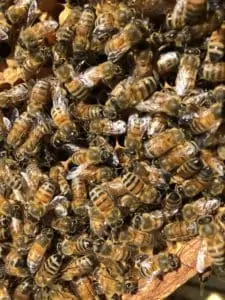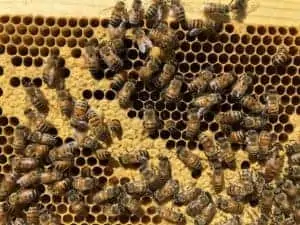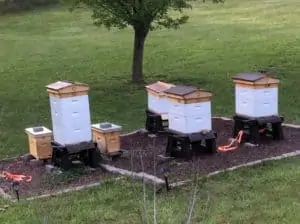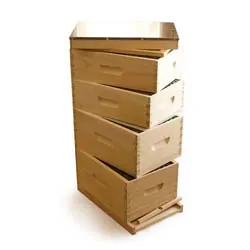As spring settles in here in western North Carolina, there are clear signs of rapid growth in my apiary. In my last blog post, I noted that the new colony of Buckfast bees was scheduled to arrive and discussed the installation of two new queens. This week we’ll be learning what a VSH queen provides to a colony. But first let me share what’s happened in the apiary since my last post.
Hive Updates
All of my colonies are showing clear signs of growth but they are definitely at different stages in this process of ramping up for summer. It is clear that I will get honey this summer, but the damage done to one of my colonies was so severe that a lot depends on how quickly they grow as to whether or not they will be a honey producer. So, let’s review what’s happening with each of my colonies.
Hive Florence
If you remember, I related having to kill Beatrice after discovering a deteriorating brood pattern and a supersedure cell that was ill-placed in the gap between the brood box and the medium box. So, I installed a caged Carniolan queen in the hive in hopes that they would quickly release her so the colony could get on even footing.
Since it had been eight days since I installed this new queen, I was curious to see what had happened in the interim. The weather turned cold right after I installed the queens with frosty nights two nights in a row. So, going in to this inspection I had a number of questions:
- Did the new queen manage to survive the cold snap given that she was caged at least during part of it?
- Had the colony released the queen?
- Was the new queen actively laying eggs?
Getting into the hive, I noted that this colony continues to eat the sugar water more slowly than their counterparts. This fact is not terribly surprising given that they are the smallest colony in my apiary. The medium box, which was my honey dome of winter stores for the colony, still has significant amounts of honey which stands to reason. The larger colonies have largely eaten through their honey stores as they have ramped up production.
Moving into the brood box, I began my search for a released queen. Moving towards the center of the box, I pulled out the queen cage and saw that it was indeed empty with the sugar candy entirely eaten through. The colony had release Lucrezia into her new home. And, I found her wandering on the back side of that frame. I took the time to mark her, placing a red dot on her thorax. She did not like my efforts but the deed was done.
So the first two questions were answered affirmatively, the new queen survived the cold snap; and, the colony had released her. I saw a few eggs and larvae but not as much as I would have liked to have seen at this point. That suggests to me that it took this colony a little longer to release her due to their smaller population. I’ll be looking at my next inspection to see significant amounts of eggs and larvae.
The colony has grown in size over the last month and foragers are bringing in pollen stores. Carniolan queens are noted for their ability to rapidly increase the size of a colony, so hopefully in a few weeks I will start seeing that kind of build-up in this colony. Even though the colony has not reached critical mass enough to want to swarm, I’ll be placed a second brood box in the coming week to attempt to forestall that from happening. I’ll continue to monitor this weakened colony until I find that it is out of danger.
I wanted to get a great picture of Lucrezia for you but unfortunately my positioning in the early afternoon sun shaded the frame she was on and you can’t really see her. So I’ll try again during my next inspection.
Hive Asgard
The arrival of my nuc of Buckfast bees has been something I have anticipated since I ordered them in January. So, when I picked them up I could hardly wait to get them back to the apiary and install them. They have a reputation of being docile bees and great honey producers. So, naively, I though I could easily transfer them from the nuc to the deep box without any trouble and without donning my suit.
It was with good intentions but with bad results.
Those bees were irritated from being locked up in that box for a while; VERY IRRITATED! I got one frame in without any problem. By the second frame, they were getting a bit more agitated. I couldn’t really spend much time locating the queen. By the time I got to the third frame I had to seat it in the hive and run. There were worker bees tangled on either side of my head in my curly hair. And yes, both of them stung me in my scalp. We all know what happens next!
The stings send out alarm pheromone and the beekeeper was running through the yard with a train of Buckfast bees busily chasing him away from the hive. In retrospect, it is actually hilarious thinking about it. At the time, I was more concerned with getting away from the hive so as to not cause further agitation. After removing myself about a 100 yards up the hill from the hives, the workers lost interest and went back down to the hive. I donned my suit and completed the process of installing the nuc.
I was definitely curious to see how this colony was settling into their new home. Working through the brood box, I still could not find Freya. This queen is adept at hiding! I’ll try again this weekend.
I did see some eggs and larvae so she is around somewhere but we’ll see if she becomes more obvious as they draw out more comb and brood starts becoming capped. That is normally when I find it easier to see a queen. I will be keeping an eye out for her when I perform my next inspection. I can say that this colony is an active one. They have been very actively bringing in pollen so they are stocking up for a growth spurt.
Hive Rome
This small colony struggled through winter in a nuc and shocked me by not only surviving but thriving! The signs of swarming seem to be alleviating and I will be placing a second brood box after the rains depart this week (looks like sometime on Saturday). My inspection revealed plenty of capped brood as well as some newly laid eggs from their new queen. I located Luna, a VSH Italian queen, and marked her. She actually tried to escape on my suit but I herded her back onto the frame after getting her marked.
I didn’t spend a lot of time in this colony as it simply needs time to settle in with its new queen and get back into a routine of rapid growth. We’ll be discussing what VSH means for us a little later in this blog post. After taking a quick look through the colony and removing some brace comb, I closed things back up and let them get back to business. This colony is very active and they are constantly coming in with full pollen baskets. Everything they need to grow is present. Stay tuned for more details in my next post.
Hive Acquitaine
This colony is the shining star of my apiary. Eleanor continues to astound me in her second year with this colony. Last week, I added a second brood box but the growth in this colony apparently has them feeling crowded so they have started producing swarm cells on the bottoms of the frames.
With so many frames in this colony fool of brood, both capped and uncapped, it is clear that the build-up in population had to be alleviated. So for the second week in a row, I decided I needed to perform a split of a colony. I removed five frames and replaced those frames with new, empty frames. I’ll relate the steps in my split as I discuss this new nuc below.
In a few weeks, I will stop feeding this colony and install a queen excluder and a honey super. This colony is going to be strong enough to produce honey for me this year. I’m quite excited by this prospect since I patiently waited last year and let the bees have all the honey they needed.
Once I get my queen castle built, I intend to start producing queens from this colony. Hopefully by my next blog post, I’ll have the queen castle built and we’ll talk about my plans for raising queens. After performing a thorough examination of the colony, I reassembled the hive and refilled the top hive feeder. This colony is voracious!
Nucleus Colony #1
I have chosen not to name my nucs yet as I intend to likely sell this nuc when it gets just a little bit stronger. If you remember, I created this colony by splitting Hive Rome and moved Cornelia into the colony. Just like she did with the nuc that became Hive Rome, she has already begun ramping up production.
With her productivity unabated, I’ll have this colony strong enough to sell in a couple of weeks. Looking through the five frames, I found plenty of brood including newly laid eggs, larvae, and capped brood. The population is already growing in this colony and foragers have begun coming out of this colony in just the last few days.
If I get to sell this nuc, it will be the first money I have made from my hobby. That’s rather exciting but will just buy more sugar and supplies.
Nucleus Colony #2
When I discovered swarm cells in Hive Acquitaine, unoccupied but still a warning sign, I decided to go ahead and create a split to create my second nuc of the season. I moved three frames of mostly capped brood into the colony and a frame of mostly eggs and young larvae.
The three frames of mostly capped brood will give the colony a fresh infusion of nurse bees to get things growing. The frame of mostly eggs and young larvae will give the current nurse bees a production line to start raising a queen. The fifth frame was full of honey and pollen to give the new colony some food stores to get them started.
I shook a few frames of mostly brood into the box to augment the population of nurse bees in the box. I also placed a top hive feeder on the colony and filled it was sugar water to give them more food to help them in their work of producing a queen. Surprisingly, I saw the first foragers actually leave the colony and return with pollen the day after I performed the split. It was a surprise but is a good sign for this colony.
I am looking forward to seeing if this colony can raise a daughter queen from Eleanor’s stock which showed strong resistance to the Varroa Mites that nearly took two of my colonies and did successfully destroy one colony. This nuc would definitely become the fifth full hive in my apiary if they successfully produce a queen. I really don’t want to grow beyond four hives at this point but with a survivor stock queen I think getting drones out of those colonies into the local gene pool is important as the colony losses in our county alone was likely close to 50% of all colonies countywide.
Dealing with Varroa Mites with Genetics
So, earlier I mentioned my VSH Italian queen that I had placed in Hive Rome. But, I realized a lot of new beekeepers may not understand what VSH means and why having queens with these genetic traits is so important in our fight against the dreaded Varroa Mite.
So, let’s start with what the acronym stands for; VSH stands for Varroa Sensitive Hygiene. The concept of breeding bees that are sensitive to the Varroa Mite and act to eradicate the pest was spearheaded by the USDA-ARS Honey Bee Lab in Baton Rouge, Louisiana.
The Lab “produced varroa resistant honey bees by selectively breeding from colonies with high percentages of infertile mites.” The Lab determined that the “heritable trait in bees which causes high percentages of infertile mites was termed ‘suppression of mite reproduction’ (or SMR trait) because we thought that the bees were directly interfering with mite reproduction.” What the Lab found was that bees with the SMR trait “were very hygienic and were able to remove varroa-infested pupae from capped brood cells.”
The research suggested that SMR bees actually “may selectively remove pupae having reproductive mites.” In a study of SMR bees with infested capped brood, the Lab discovered that the “SMR bees removed 91% of pupae having reproductive mites and 58% of pupae having infertile mites that had produced progeny.” The conclusion was that the presence of mite offspring triggered the hygienic reaction.
The success of the USDA Bee Lab in breeding for resistance to Varroa Mites also produced beneficial genetic traits that over generations of bees has resulted in enhanced resistance to American Foulbrood and Chalkbrood not to mention defense against wax moths and small hive beetles. There are now VSH Italian and VSH Carniolan queens available.
But, another option exists for fighting Varroa Mites, in the form of Russian queens. These queens are of pure Russian stock produced from 100 Russian queens from the Primorsky territory imported by the USDA-ARS lab in 1997. Research began early in 1998 when the queens and their colonies were move to apiaries near the lab.
After finding resistance to Varroa Mites with these bees, 40 Russian queens were selected to produce daughter queens for two extensive field trials in which the resistance of the Russian honey bees to V. jacobsoniwas directly compared to that of domestic honey bees commonly used commercially in the United States.”
To ensure that the best genetically resistant Russian queens would be produced, one queen was chosen where the colony had shown extremely strong resistance to the Varroa Mite. A mating station was established on an isolated island to ensure that “the desired combinations of queens and drones” would be present to allow natural matings to produce high genetic diversity and to allow the queens to mate with about 20 drones. The program to create Russian queens involved a collaboration with the Russian Academy of Sciences which allowed for the importation of the best Russian queens for possible inclusion in the study and to enhance the genetic diversity of the program.
As part of these efforts to combat Varroa Mites, the Russian Honey Bee Breeders Association was formed to “maintain and improve the genetic lines of Russian honey bees through propagation and selective breeding.” The association’s web page points out that “There are 17 lines of Russian Queens divided into 3 groups called Block A, B, and C.” This is done to avoid inbreeding while making improvements through selective breeding.
The Association’s plan “calls for mating queens from Block A to drones from queens of Block B and C, mating queens from Block B to drones from queens of Blocks A and C, and so on.” To become a certified breed for the Russian Honey Bee Breeders Association, you have to have an isolated mating yard stocked with sufficient numbers of appropriate drone source colonies.
Where VSH bees resist mites by removing infested pupae, Russian bees show multiple mechanisms for the resistance to mites including:
- Varroa Sensitive Grooming (VSG) – Russian bees have been observed ‘biting’ Varroa Mites and inflicting damage causing them to die,
- A high level of Varroa Sensitive Hygiene (VSH),
- A much higher proportion of Varroa Mites are found on adult bees rather than reproducing in the colonies’ brood thus slowing the Mite Population Growth (MPG) and contributing to the success of VSG, and
- More frugal behavior in brood rearing meaning that they shorten the time in which they are rearing brood based on resources which decreases the MPG and again contributes to the efficacy of VSG.
Yes, there are lots of acronyms associated with honeybees that have genetic traits that make them resistant to Varroa Mites. But, having bees resistant to Varroa Mites is one additional armament in our arsenal in producing colonies that survive and thrive. Using VSH bees or Russian bees allows the beekeeper to enhance their IPM procedures for dealing with mites and for those beekeepers who want a more natural approach, these Varroa-fighting bees are an absolute must.
Coming Soon
Now that I’ve bewildered your brain with lots of science and a host of acronyms, I will let you digest it all. I encourage you to follow some of the links peppered through the blog post and also the links I’m listing below as source material. Genetics often determines much and honeybees prove that fact yet again. I encourage you to learn more about this and possibly make an effort to get VSH queens.
By the way, getting a Russian queen requires proactive efforts. I tried to get Russian queens for this spring but all of the queens were already reserved. So, I’m on a waiting list and will receive them this year if someone decides they don’t want the queens they have reserved. I have already placed myself on the list for next year’s queens so that I would avoid missing out.
In my next blog post, I will share more updates on the growth in my colonies and will try to get you a solid picture of my new queens, including that elusive Buckfast queen! I also will relate how things go with my first treatment for Varroa Mites this season (Formic Pro). And, if some of you have topics you would like me to cover, please write comments to this blog post so I can start doing research.
Until next time, Happy Beekeeping!
Resources
- USDA-ARS Honey Bee Breeding, Genetics, and Physiology Laboratory: Baton Rouge, LA.
- Varroa Sensitive Hygiene (VSH)
- “Varroa Sensitve Hygiene VSH: The natural way to control mites and brood diseases.” Glenn Apiaries website.
- Varroa Sensitve Hygiene and Mite Reproduction.
- Selecting for Varroa Sensitive Hygiene.
- Russian Honey Bees



